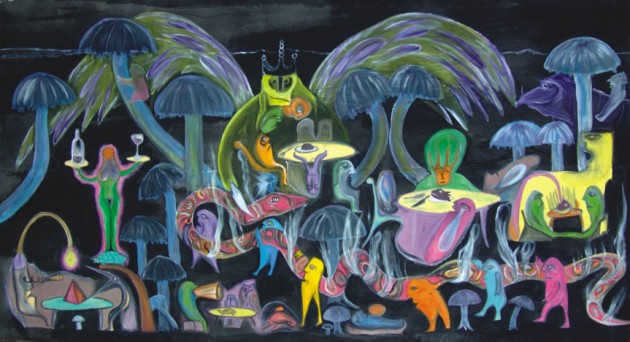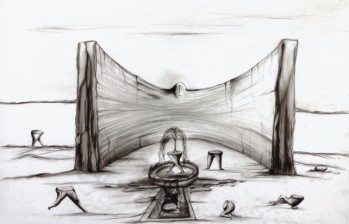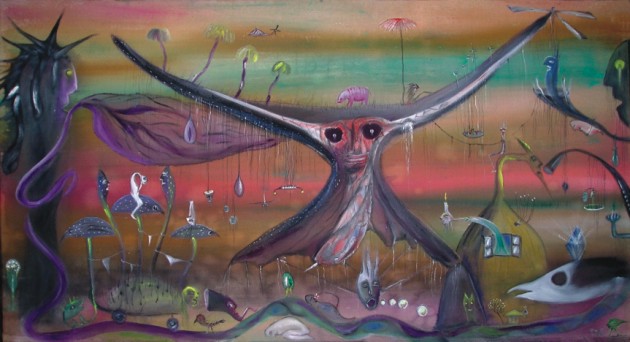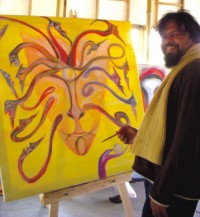| Home - Back Issues - The Team - Contact Us |
 |
| Volume 10 |Issue 08 | February 25, 2011 | |
|
|
Art
An Avant-garde Artist Fayza Haq Ronni Ahmmed is one of the young avant garde artists who has made a name for himself for experimenting with the unconventional and thereby catching the viewer's attention. He has had an exhibition at Adelaide, Australia and many solos and group exhibitions at Alliance Française, Bengal Gallery, a gallery at Baridhara; he hopes to be part of a group exhibition at Goethe Institut shortly. Ronni has also taken part in Britto's workshops outside Dhaka. His huge scroll-like pieces that cover myths, legends, and combines the past and future existence of man and nature , use symbols and stories, using human, animals and creatures from imagination. The colours and lines are dramatic and subtle. His gallery of beings have a whole collection of quixotic creatures, who reach out to outer space and the distant past. His is a subtle blend of history and “supersonic” mind blowing thinking about the present and future. The philosophers, through the years, have taught how to reach happiness and contentment. Ronni believes that the human mind is always hoping to live on. “We consciously hope to live. Happiness, tranquillity and peace are a state of the mind which we hope to reach. To reach perfect happiness, one should be able to assess the desires. Once the desires are fulfilled one can go on to the element of peace, that is sought the world over, and an artist attempts to bring this through his work.” The artist, Ronni says, should be clear about his existence. He believes that an artist cannot be a worldly being, who is thrown into the world with his talents and the materials to express his dreams. He says that there is no simple prescription for the lust for life. Each one's concept of peace and happiness is an individual one. Asked if an artist can survive presenting his own image of life and living that exists in his mind? Does he necessarily need to be honest? To this Ronni Ahmmed says the theme of life and death constantly preoccupies an artist's mind. For some artists, who are hypersensitive, says Ronni, being successful with colours and canvases means “walking on a tight rope”. It is not as easy as some nine-to-five desk job, where one gives the “boss” what he wants. Blending dreams and desires on canvas is much more complex. Speaking of harmony, spinning songs of desire with colours – and at the same time holding up the mirror of truth – is a trifle difficult. An artist's work is not cut and dried. He says, “While the artist celebrates life, he takes one wrong step, and so destroy his life. The artist's existence is no 'bowl of cherries'– whether in Paris or Punjab.”
Thus, for Ronni Ahmmed, an artist's life is not to envy, as it's a tricky one, and maybe full of pitfalls, if one listens to the dictates of the heart and soul, and not just the gallery owners. “A true artist is always preoccupied with life and death. He is not satisfied with presenting Bangladeshi drums, fish, buffaloes, kites etc – so that the viewer is moved by the artist's penchant for reaching out for roots. In the international stage, the art business is a huge business–which stretches on from the US to China. This business, we know, is controlled by gallery owners and others with large bank accounts who can control them. It is the post colonial ruling class, who call the shots, as colonial rulers did in the past. 'Money talks' as they say, and not necessarily the integral talent or perseverance.” “The common people and the buyers also have to play a role in the mega structure of the art market. If an artist hangs on to the conventional and routine, he cannot make waves, I feel. Building up a career is an uphill task. The artist must know the latest trends: He has to go along with these nouveau dictates. For a good artist there is an invisible formula or prescription. It remains disturbing that artists are dominated by capitalism and many of the top notch artists will agree with this. Capitalism is programmed and designed by those with enormous bank accounts. A successful artist has to be well aware of this. There is a lot of pressure on an artist, I believe.” An artist, according to Ronni Ahmmed, remains bound and controlled by factors beyond himself. Artists are often misunderstood, and some are even labelled as “mad” for being different, especially by those viewers, who understand art only superficially. They tend to say, this artist is obsessed with this; or all this artist do is repeat this oft-repeated theme. Writers and composers, who are offbeat, are not so often misconstrued. Many viewers, even in the last two centuries, don't tend to take painters and sculptors seriously– and Ronni Ahmmed is one of those artists who resent this attitude strongly. It's been a long time since the great wars took place. Bangladesh has been in existence for forty years. Many galleries and art schools serve as outlets and patrons. It's high time that striving artists are given their due place in our society. We, in Bangladesh, are not always open-minded–especially to elements like surrealism–something that attacks the regular mind. Things are changing gradually, says Ronni Ahmmed. In Bangladesh “off beat” is seeing just a beginning, he says. Numerous artists are trying to set trends.
Asked how our artists fare, compared to those, say across the border, he says, in India – they tend to look eastwards like Ajanta and Elora , whereas our senior artists like Safiuddin Ahmed , Mohammed Kibria and Rafiqun Nabi have looked to the west for inspiration–for their mentors. They have studied in Europe and have places like France, the UK, and Greece in mind, as their ideal, says Ronni Ahmmed, “Bangladeshi art is in the process of being formed. It is in a state of flux. It is moving somewhere... the artists from 1990 s are trying to do something fresh and new, I believe. To express new socio-economic and political situations, I feel we should go for something global–an 'international language'. If one wishes to retain the 'Bangladeshi signature', like say in what Abdus Shakoor did, and we wish to retain, as in our cultural motifs. We should, I feel, portray our local legends myths. There is also the Mahabharata, which is followed even in Sri Lanka. In my art work, I tend to bring myths such as that of Noah and his ark, as found in the books of the revealed religions. Myth is the story of mankind which deal with holocausts and the two major world. It is I believe, the time of grand narrations. The big airlines, MacDonald's and the Microsoft companies are like mythical giants of our age: The corporate world is another myth. They consume everything around and dominate the modern mind. In our twentieth century we've developed weapons that can destroy the world. This has never happened before.”
“As a result Nature is being mercilessly destroyed in the name of progress and civilisation– as most artists feel. One should know the multi-layers, and hidden secrets of the myths. Dali, Picasso and important painters of the modern times have all gone for portraying myths, like the 'Guernica'. The myth of the fructification has been repeatedly dealt with by the master painters of Europe. I believe we have modern myths too like Hitler of World War II, I believe. On the other hand, Fidel Castro is the most positive character of the modern times, many feel. Similarly Pele and Che Guevara are the legends of our times. It is keeping such personalise in our mind that the Surrealistic painter of today's world moves." Talking about the subject of gallery owners dictating term to gallery artists, Ronni Ahmmed says that each gallery has its own rules and agenda. If one doesn't go along with them, one gets lest out in the race. Conditions apply to be reckoned as a painter in demand. The gallery owners too are subjected to dictates of buyers, who want a well-known painter's work to deck their living rooms. An artist, says Ronni Ahmmed, is a time traveller. His mind oscillates through time past and time present. Copyright
(R) thedailystar.net 2010 |




